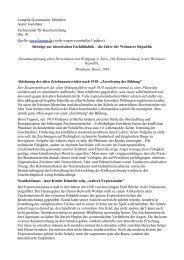Research in Visual Arts Education - The National Society for ...
Research in Visual Arts Education - The National Society for ...
Research in Visual Arts Education - The National Society for ...
You also want an ePaper? Increase the reach of your titles
YUMPU automatically turns print PDFs into web optimized ePapers that Google loves.
ART, DESIGN AND ENVIRONMENTAL PARTICIPATION<br />
<strong>Education</strong>al objectives and legitimation<br />
Questions related to objectives <strong>for</strong> art and design education are <strong>in</strong>separably<br />
l<strong>in</strong>ked to the legitimation of the subjects <strong>in</strong> primary and secondary school.<br />
Consequently, this is a frequent research topic when study<strong>in</strong>g educational<br />
practises. In Norway we have a legacy <strong>for</strong> discuss<strong>in</strong>g these questions with a<br />
base <strong>in</strong> what happened 75 years ago. In 1931 educators of art and craft built<br />
a common association <strong>for</strong> teachers; Norsk tegne- og håndarbeidslærer <strong>for</strong>bund<br />
[Norwegian Association <strong>for</strong> Teachers of <strong>Arts</strong> and Craft]. This merge <strong>in</strong>to a<br />
common association had its base <strong>in</strong> emerg<strong>in</strong>g pedagogical ideas, as opposed<br />
to the craftsman tradition. Thirty years later, <strong>in</strong> 1960, these ideas of merg<strong>in</strong>g<br />
the two traditions were implemented <strong>in</strong> the national curriculum. <strong>The</strong> conflict<strong>in</strong>g<br />
ideas between the pedagogical aims and the craftsman tradition<br />
have <strong>for</strong> years been a ma<strong>in</strong> issue when discuss<strong>in</strong>g everyday practise <strong>in</strong> the<br />
Norwegian primary and lower secondary education. Consequently, the educational<br />
aims <strong>for</strong> and content of, as well as the discussions on legitimation<br />
of the subject, have been important issues <strong>for</strong> Norwegian researchers, perhaps<br />
more important than <strong>in</strong> any other Nordic country.<br />
<strong>Research</strong>ers as Liv Merete Nielsen, Marte Gulliksen, Karen Brænne and<br />
N<strong>in</strong>a Skott Frisch have studied how different traditions and philosophies<br />
have <strong>in</strong>fluenced the everyday practise and outcome <strong>in</strong> art and design education<br />
at different levels. <strong>The</strong> curricula of 2006 (Kunnskapsløftet) represent<br />
a balance where the tradition of the creative art, the visual culture (<strong>in</strong>spired<br />
by Nordström, 1972), the craftsman tradition and the empowerment<br />
orientation (<strong>in</strong>spired by Freire, 1970) contribute to the children’s creation<br />
of artefacts with required contextual quality and function. Knowledge and<br />
skills developed <strong>in</strong> art and design education function as a base <strong>for</strong> democratic<br />
participation <strong>in</strong> cultural, social and environmental developments of everyday<br />
life, where strategic choices have to be made. In such a context the pedagogical<br />
paradigm of self-expression and the craftsman tradition of skills<br />
are complementary, not contradictory. Arne Marius Samuelsen (2003), Venke<br />
Aure (2006) and Guri Østby (2006) have <strong>in</strong> their research been occupied by<br />
the dissem<strong>in</strong>ation of art, and art as a po<strong>in</strong>t of departure <strong>for</strong> philosophical<br />
discussions. <strong>The</strong> appreciation of art, as a goal <strong>in</strong> itself, is also discussed.<br />
<strong>National</strong> evaluations<br />
Two evaluations of school practise have been made <strong>in</strong> 1995 (Carlsen & Streitlien)<br />
and 2003 (Kjosavik, Koch, Skjeggestad & Aakre). <strong>The</strong> report from 2003 has a<br />
focus on the implementation of the L97 curriculum. Both reports conclude<br />
that the subject is a highly valued subject among the children. It also reveals<br />
that changes with<strong>in</strong> the educational system are a very slow process. In 2001<br />
NORDIC VISUAL ARTS EDUCATION IN TRANSITION 137



